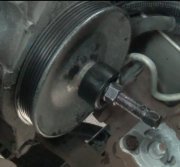Hi hgval614. Welcome to the forum. Lack of power assist can be real miserable to figure out the cause. Low pressure provided by the pump is common, and internal leakage in the rack and pinion assembly is common. It can be impossible to tell which is the cause without special tools that most shops don't have.
One thing that will help a lot in the diagnosis is if you can observe one detail when the problem occurs. Does it turn equally hard in both directions or will it at times turn easier one way than the other? GM had a REAL big problem with "morning sickness" but it can happen to any car with rack and pinion steering. When high pressure fluid leaks internally past the seals, it bypasses the power piston rather than pushing on it. This almost always affects turning in just one direction first, and clears up within a minute or two as the fluid heats up. Turning in the other direction feels normal but will also be affected a few weeks later. After that initial loss of assist in the morning, hence the name of the problem, the power assist is normal for the rest of the day. As the problem progresses, it takes longer and longer before the power assist starts working.
When pump output is weak, the assist in both directions will be lost at the same time. One potential clue is it will usually come back when raising engine speed a little above idle. This is due to worn vanes in the pump itself. The German-made "ZF" style pump had a lot of trouble with that on early '90s Chrysler products. That pump was used on a lot of other cars so it would stand to reason those cars would develop the same problem.
There is also a pressure relief valve in the pump housing that can cause problems but it is not available separately. I don't know how it does it, but it actually reduces pump pressure when no power assist is requested, and it raises pressure when you need power assist. I've never heard of anyone caring if the low pressure was caused by the pump or pressure relief valve. They were just satisfied when the new pump solved the problem.
The special tool for determining the cause of pressure problems consists of a hose that is inserted between the pump and steering gear on the high pressure side. A valve and pressure gauge are part of the hose assembly. When the problem is occurring, the valve is quickly closed for a few seconds and the gauge reading is observed. Since fluid flow to a potential leak is blocked, if pressure builds instantly to over around 1100 psi, that proves the pump is capable of developing the required pressure. When the test valve is opened, if pressure drops, that is proof internal leakage is taking place in the rack assembly.
That internal leakage is what happened to every GM front wheel drive car in the '80s and early 90s. The fix was to install a new spool valve with new sealing rings, (these parts are not normally available separately), but the real cause was grooves worn into the soft aluminum housing from those teflon rings. The fix was only temporary. It was just designed to get the car out of the 50,000 mile warranty period. The customer had to foot the bill later for the permanent fix which was a rebuilt rack and pinion that was modified with a stainless steel liner for those seals to ride on. All aftermarket remanufacturers like Moog and Federal Mogul perform these modifications on their products so the quality is much better than what came from the manufacturer.
One last thing that is becoming more of an issue is variable assist power steering. That is a gimmick that influences people to buy one car over another, so eventually every manufacturer copied the idea. I'm only familiar with the Chrysler version to limited extent. I've only seen a problem on one car in 20 years as a steering, suspension, and alignment specialist, but it shouldn't be overlooked. The systems work by adding a valve to the rack and pinion housing that allows pressurized fluid to bypass the power piston. Of course that requires another complicated, often unreliable computer module to operate that valve. Chrysler's system is run by the Transmission Computer since he knows when power steering assist should be needed. If you car has variable assist, expect that to add more difficulty to the diagnosis.
Your mechanic's comment about it taking a while before the new pump felt right was in reference to trapped air bubbles working their way out of the system which can be frustrating on some cars. Fords, for example, will seem to work just fine but will blubber a bunch of fluid onto the ground when the engine is stopped. Special tools have been developed just for those systems to address the problem, but on most cars there will just be reduced power assist or a buzzing noise for a few days. Sometimes the best thing to do is just drive the car rather than waste a lot of time, ($$) trying to solve what will take care of itself.
Diagnosing your specific problem is going to be a little confusing too because since the power assist came back after a few days or weeks, it suggests the pump is not the problem. They usually aren't intermittent. When they fail or get weak, it's permanent. Intermittent operation is characteristic of the rack and pinion, but it is rare for them to cause lack of assist equally in both directions starting at exactly the same time. No one likes to say it or do it, but sometimes you have to install a new part to see if it solves an intermittent problem. Based on your description, my vote is for the rack.
Caradiodoc
Monday, July 5th, 2010 AT 12:46 PM


